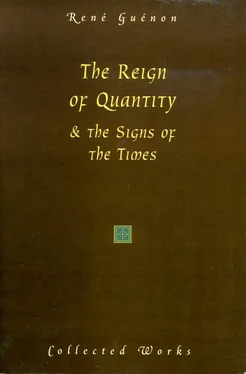Another important consequence arising from these considerations is that the end of the cycle as well as its beginning is ‘intemporal’, and this is necessarily so because of the strict analogical correspondence existing between the two extreme points; thus it comes about that the end is in fact the restoration of the ‘primordial state for the humanity of the cycle in question’, and this also makes clear the symbolical relation of the ‘Heavenly Jerusalem’ to the ‘Terrestrial Paradise’. It is also a return to the ‘center of the world’, the exterior manifestation of the center taking the forms, at either end of the cycle, of the ‘Terrestrial Paradise’ and the ‘Heavenly Jerusalem’ respectively, with the ‘axial’ tree growing in the middle of both the one and the other. During the whole interval between the two, that is, during the course of the cycle, the center is however hidden, becoming indeed more and more so, because humanity has moved gradually away from it, and this is fundamentally the real meaning of the ‘fall’. The conception of a movement away from the center is only another way of representing the descending course of the cycle, for the center of a state such as ours, being the point of direct communication with superior states, is at the same time the essential pole of existence for that state; a movement from essence toward substance is thus a movement from the center toward the circumference, from the interior toward the exterior, and also, as is clearly shown in this case by the geometrical representation, from unity toward multiplicity. [106] Another significance of the ‘inversion of the poles’ can be deduced from this, since the course of the manifested world toward its substantial pole ends at last in a ‘reversal’, which brings it back, by an instantaneous transmutation, to its essential pole; and it may be added that, in view of this instantaneity, and contrary to certain erroneous conceptions of the cyclical movement, there can be no ‘reascent’ of an exterior order following the ‘descent’, the course of manifestation as such being always descending from the beginning to the end.
The Pardes , inasmuch as it is the ‘center of the world’, is, according to the primary meaning of its Sanskrit equivalent paradesha , the ‘supreme region’, but it is also, according to a secondary meaning of the same word, the ‘distant region’, ever since it has become, in the course of cyclical development, actually inaccessible to ordinary humanity. It is in fact, at least apparently, the most distant of all things, being situated at the ‘end of the world’ both in the spatial sense (the summit of the mountain of the ‘Terrestrial Paradise’ touching the lunar sphere) and in the temporal sense (the ‘Heavenly Jerusalem’ descending to the earth at the end of the cycle); nevertheless, it is always in reality the nearest of all things, since it has never ceased to be at the center of all things, [107] This is the Regnum Dei intra vos est of the Gospel.
and this brings out the inversion of relationship between the ‘exterior’ and ‘interior’ points of view. Only, in order that this proximity may be actually realized, the temporal condition must necessarily be suppressed, because it is the unfolding of time in conformity with the laws of manifestation that has brought about the apparent separation from the center, and also because time, according to the very definition of succession, cannot turn back on its course; release from the temporal condition is always possible for certain beings in particular, but as far as humanity (or more exactly a humanity) taken in its entirety is concerned, a release from time obviously implies that the said humanity has passed completely through the cycle of its corporeal manifestation: only then can it, together with the whole of the terrestrial environment that depends on it and participates in the same cyclic movement, be really reintegrated into the ‘primordial state’, or, what is the same thing, into the ‘center of the world’. This center is where ‘time is changed into space’, because it is where the direct reflection in our state of existence of the principial eternity is found, and thereby all succession is excluded: moreover death cannot attain thereto, so that it is also the very ‘seat of immortality’; [108] On the ‘seat of immortality’ and what corresponds to it in the human being, see The King of the World .
all things appear therein in perfect simultaneity in a changeless present, through the power of the ‘third eye’ with which man has recovered the ‘sense of eternity’. [109] On the symbolism of the ‘third eye’, see Man and His Becoming according to the Vedanta and The King of the World .
Having given some attention to the end of the cycle, it is now necessary as it were to turn back again, in order to examine more fully the causes that can, under the conditions of the present period, play an effective part in leading humanity and the world toward that end. Two contributing tendencies may be distinguished, and their description involves the use of terms suggesting an apparent antinomy: on one side is the tendency toward what has been called the ‘solidification’ of the world, and it is this that has been mainly considered so far, and on the other side is the tendency toward the dissolution of the world, and it remains to examine in detail the action of the latter, for it must not be forgotten that every such end necessarily takes one form and one only, that of a dissolution of the manifested as such. Let it be said at once that the second of the two tendencies now seems to be beginning to predominate; for, in the first place, materialism properly so called, corresponding as it clearly does to ‘solidification’ in its grossest form (the word ‘petrifaction’ could almost be used, by analogy with what minerals represent in this connection), has already lost much ground, at least in the domain of scientific and philosophical theory, if not yet in that of the common mentality; and this is so far true that, as pointed out earlier, the very notion of ‘matter’ as it existed in these theories has begun to fade away and to dissolve. In the second place, and correlatively to this change, the illusion of security that held sway at the time when materialism had attained its greatest influence, and that was then more or less inseparable from the prevailing idea of ‘ordinary life’, has in the main been dissipated by the events that have taken place and the speed of their succession, so much so that the dominant impression today is very different, for it has become an impression of instability extending to all domains. Since ‘solidity’ necessarily implies stability, this again shows clearly that the point of greatest effective ‘solidity’ within the possibilities of our world has not only been reached, but has also already been passed, and consequently that dissolution is the goal toward which the world will be traveling henceforth.
The acceleration of time itself, as it becomes ever more pronounced and causes changes to be ever more rapid, seems to lead of its own accord toward dissolution, but it cannot for that reason be said that the general direction of events has been modified, for the cyclical movement inevitably continues to follow the same descending course. Moreover, the physical theories just referred to, while they too change with growing rapidity like everything else, continue nonetheless to take on a more and more exclusively quantitative character, to such a point that their character has now become assimilated to that of purely mathematical theories, and this change, as previously indicated, takes them yet further away from the sensible reality that they claim to explain, and leads them into a domain that is necessarily situated on a lower plane than that of sensible reality, as was explained earlier when pure quantity was under consideration. In any case, the ‘solid’, even at its greatest conceivable density and impenetrability, by no means corresponds to pure quantity, having always at least a minimum of qualitative elements; it is moreover corporeal by definition, and is even in a sense the most corporeal thing possible; now ‘corporeality’ is by definition such that space, however ‘compressed’ it may be under the conditions appertaining to a ‘solid’, is necessarily inherent in its constitution, and space, let it be recalled again, can in no way be assimilated to pure quantity. Even if the point of view of modern science were to be adopted momentarily, so that on the one hand ‘corporeality’ could be reduced to extension in accordance with Descartes’ ideas, and on the other hand space could be regarded as nothing but a mere mode of quantity, the difficulty still remaining would be that everything would be still be in the domain of continuous quantity; a change to the domain of discontinuous quantity, that is, of number, which alone can be looked upon as representing pure quantity, must then obviously imply, by reason of the said discontinuity alone, that neither the ‘solid’, nor anything else that is corporeal, can subsequently be taken into account.
Читать дальше











